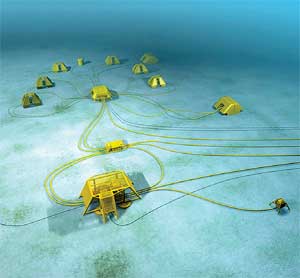What's new in production
Subsea processing progresses slowly
Subsea processing. The main benefit of subsea processing seems obvious: reduce hydrostatic head, lighten topside facilities and keep fluid/solid separation close to the seabed for reinjection of produced water and solids. Flowlines would then carry crude and gas alone, so that a final polishing could be accomplished onshore, saving even more capital. This vision is compelling, but its implementation has taken decades and its advances are adopted slowly. In 1985, the first subsea Christmas tree was installed followed in 1993 by the first subsea multiphase pump. Separation systems weren’t implemented until 1999 for liquids and gas-liquid flow separation wasn’t attempted subsea until 2001. This year, the first combination subsea separation, boosting and injection system will be installed in the North Sea at the Tordis SSBI development, Fig. 1. Compression and power distribution systems are being planned at Ormen Lange in the North Sea.
Perhaps the slow uptake is due to the relative youth of many deepwater developments, even though application of the technology can be effective in the early years of a field, when reservoir pressures are high. Early implementation can create new optimization strategies for smaller facilities and the staged tie-in of marginal fields to produce clustered field developments. Once pressure begins to decline in a reservoir, liquid water knockout combined with reinjection can help with pressure maintenance to produce more late-life oil and extend the economic life of the field and subsea processing system. There are many engineering challenges to overcome and keeping up with the advances of manufacturer’s equipment, system configurations and operator’s implementation requires a group effort. To this end Intec Engineering began a joint industry study early this year for subsea processing technologies. The goal is to assess subsea separators, pumps, and compressors, as well as power and control module needs. The study has attracted 15 participants and should be completed by summer’s end. Perhaps it will encourage the industry to make full use of present subsea processing technologies to move deepwater fields’ economic limits out a few more years and expand the economic envelope for future deepwater development. Iraqi production opportunities. Iraq’s draft hydrocarbon law, which should be approved soon, covers tens of undeveloped and underdeveloped fields and will open them to foreign investment. According to news reports, the field development projects will be offered in four groups. The first two groups will be controlled by the to-be-established Iraqi National Oil Co., which will negotiate for foreign investment or develop the fields on its own. Group 1 holds producing fields (27) with additional potential, including southern fields Majnoon, North Rumala and South Rumala. Group 2 holds undeveloped fields (25) with proven reserves near infrastructure supporting existing producing fields. This group includes fields in the north: Ismail, Makhmour and Qarah Jwaq; in the center of the country: Himreen, Mansouriyia and Nahrawan; and in the south: Howzah, Rattawi and Siba. Group 3 will be developed by Iraq’s Oil Ministry in Baghdad and by the Kurdistan Regional Government (KRG), both will negotiate and sign initial contracts. These contracts will then be reviewed and approved by a federal oil and gas council. This group holds scattered fields (26) away from infrastructure in several provinces including Anbar, Kirkuk, Muthanna, Najaf and Suleimaniya. Group 4 is formed from undeveloped/unexplored blocks (65) in the Western Desert, mostly in Anbar province. KRG will control blocks in Kurdish provinces Dohuk, Erbil and Suleimaniya with the Oil Ministry handling the rest. The new law will require all prior contracts negotiated with the earlier Iraqi government or with Kurdish authorities to be reviewed by an independent consultant, appointed by the federal oil and gas council. For companies willing to risk Iraq’s instability, new opportunities await. New production. Chevron began producing oil from Bibiyana field in the Habiganj District’s Block 12 in northeast Bangladesh. The gas field will produce 200 MMcfd at startup with a ramp up to 500 MMcfd over the next three years. The field has 12 development wells, a gas plant, a natural gas pipeline and a condensate pipeline. China National Offshore Oil Corp. started oil production oil from offshore field, Bozhong 34-5. The field is one of the smallest offshore fields China has developed with a recoverable reserve of 11.3 million bbl of oil. Melrose Resources began gas production from Egypt’s West Khilala development in the Nile delta. The field is producing 80 MMcfd. Petrobras’ Manati field started gas production offshore Bahia state in Brazil’s Camamu basin. The field is producing from two wells at 70.6 MMcfd. The production platform is fully automated, remotely controlled and equipped with a monitoring system. The company plans to drill five additional wells later this year, which should increase production to 212 MMcfd, once they are online. Gas comes to shore through 77 mi., 24-in. pipeline to a processing station at Sao Francisco do Conte, some 62 miles from Salvador, Brazil. The field was discovered by Petrobras (operator) in consortium with Queiroz Galvao and Norse Energy. Elsewhere offshore, Petrobras will soon start producing from two additional oil facilities. Off the northeastern coast of Sergipe state, 20,000 bpd will come on-line from Piranema field and off Espírito Santo state, the Golfinho oil field will begin producing 100,000 b/d through the FPSO Cidade de Vitoria. The company plans to start more fields later in the year.
|
|||||||||||
- What's new in production (February 2024)
- U.S. operators reduce activity as crude prices plunge (February 2024)
- U.S. producing gas wells increase despite low prices (February 2024)
- U.S. oil and natural gas production hits record highs (February 2024)
- Dallas Fed: E&P activity essentially unchanged; optimism wanes as uncertainty jumps (January 2024)
- Mixed outlook for activity on the UK Continental Shelf (December 2023)





